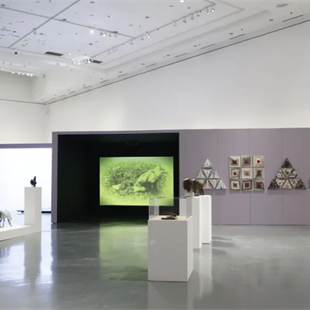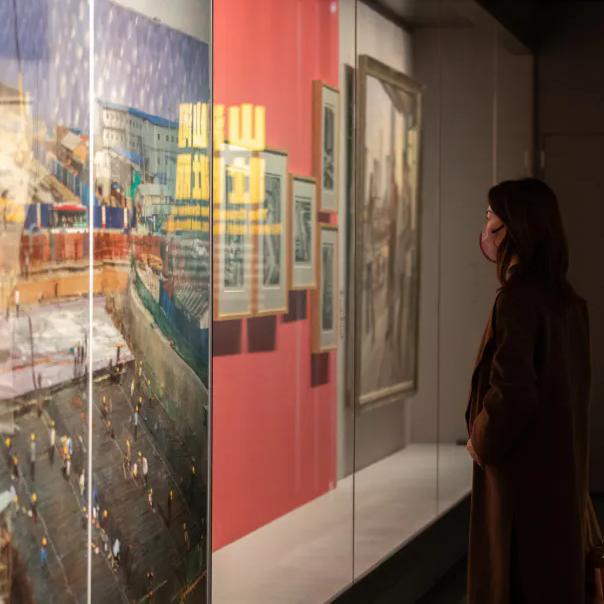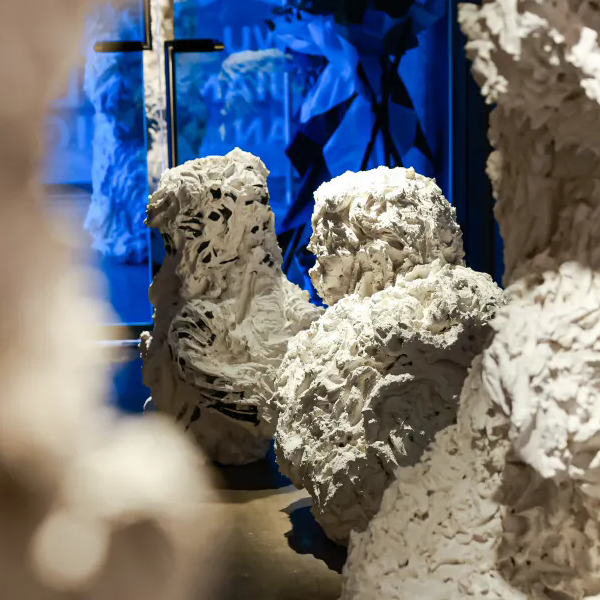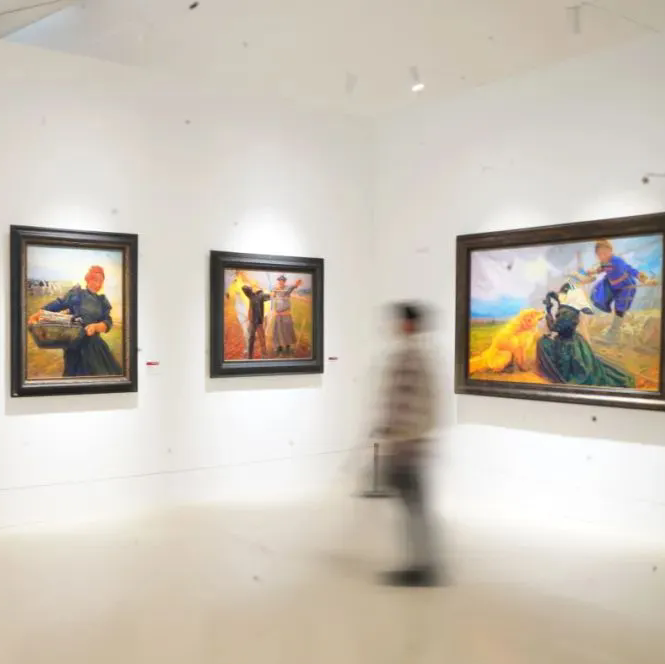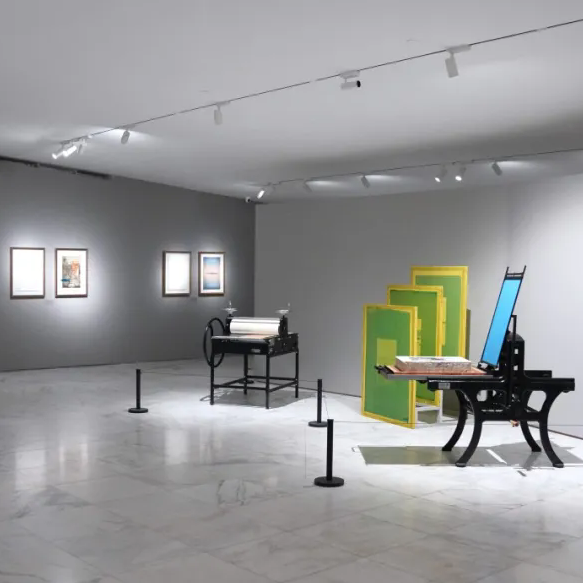Perface
by Leng Lin
Zhang Xiaogang's art works have long followed us like a shadow in the contemporary art world, consistently attracting our attention. This attraction originates as his art always maintains a relationship with history and memory. In 1992, Zhang began employing these themes in making his art. They were not generated by outside factors or imagined; they came from the artist and his own culture. Since then, images derived from these themes began to continually appear in his art works. The figures and scenes in his Big Family, Memory and Amnesia, and Green Wall series are Zhang's record of his memory as a witness of China's history.
In 2004, Zhang began experimenting with photography; this change of medium did not alter his themes. The artist photographs according to his memories and feelings. These images seem casual and mundane. They include scenes Zhang is familiar with, such as images of daily life and old film stills well-known among Chinese people of his generation. Though casual in appearance the images are full of memory-related meaning, and Zhang records on their surfaces in journal format the feelings he had during the creation of these pieces. He writes about the literature and poetry he has loved since his youth, excerpts from Western philosophy that were once craved and loved by Chinese intellectuals, as well as his private thoughts and emotions. In previous series such as Big Family, the characters were the link to the subject of memory and history, but in the photographic works these individuals appear less as the artist's text comes to the forefront. His text is now his tool for unearthing memory and maintaining a relationship with history. Meanwhile, the artist is also attempting to restore the ancient Chinese literati tradition of inserting texts in paintings. The act of inserting texts in painting is conceptual, while the texts themselves have concrete meanings. The title of the exhibition, The Records, refers to the artist's effort to contextualize the imagery and make the text visible.
[gallery link="file" orderby="title"]
The title of the exhibition is derived from the well-known Han Dynasty text Records of the Great Historian, but is more a reflection of Zhang's never-ending quest to explore the trail of history. He is good at using seemingly subtle objects to continue his sensitive depiction of memory: from the beginning bloodlines, light spots, trail of tears to the later faraway skylines, the overhead electrical wires that appeared to travel freely across the canvas planes, down to the objects which people would usually turn a blind eye to, such as a lamp cord or electrical cables. Zhang makes connections between abstract history and concrete living through the use of these details. In this way, he is constantly reminding us that every individual grows up amidst this abstract yet concrete history. Just as in our neighboring country Japan, we are experiencing the split of contemporary life and the past culture with our rapid development of political and economical globalization. Under such circumstances, Japanese artist Takashi Murakami put forward the idea of “Superflat”, which is to treat the contemporary culture with an attitude of de-emphasizing history. However in China, Zhang is using the opposite attitude to embrace the past to explore new cultural possibilities, new dimensions in the search of history and memory.
In his new exhibition, Zhang employs new material in his painting process by using stainless steel plates instead of canvas. Sketches are screen printed onto the stainless steel plates, then Zhang modifies and reworks the printed work directly onto the surface. He also continues the “recording” method he employed in his photographic works, writing down his thoughts and feelings during the creation of these works. In this creative process, we can still feel that the artist is corresponding with history (or “the past”) and memory has an individual aspect. When he “publishes” these sketches on stainless steel it is like placing them in the “past tense,” and the revisions and texts he adds are the narratives and subject matter that pile up and overlap on “the past” and “history”. He is consciously having a dialogue with himself and his culture. Through such dialogue, the artist attempts to open himself up and the cultural space around him, thereby establishing a new type of cultural attitude and orientation.
In the work of August 30th, he wrote:
——. In the past twenty years, there are some problems that always linger between these two questions (actually it's really two sides of the same question). Since to “desert”(escape) something allows us to hold our ground on certain things we have already made up our minds about, and it's not like what people often like to say such as “being persistent” , “being devoted” among other sayings, which glorifies the concept. Moreover, it's because “confrontation” forces us to have some basic judgment in our road of search and pursuit. Thus, it’s continuously adjusting to our direction. Therefore, we often have these feelings, in order to be better prepared to “confront” them, we have to first learn how to “escape”? On the other hand, what you are escaping from is often exactly what you must confront. ——.
The artist's historical viewpoint comes from “escape”, instead of from more typical sources such as “being persistent” and “being devoted”. Through “escape” the artist avoids some direct artistic questions, but really pours in “eventful”, “story-like” and “complicated” contents into his art.
In the work of August 21st, he wrote:
——. This reminded me of a conversation I had with someone a few days ago on how memory is not for the purpose of restoration, not even for the purpose of nostalgia, memory is a mere process, and it's one of the many methods of enjoyment we have today. The speed of the changes in our life has already exceeded our psychological recognition and acceptance of time. Nowadays I would think we have already started to be “nostalgic” when we are still very young. What does this really imply? Is it that we are starting to be overly obsessed with memory? Or is it that we are starting to doubt our memories?
“Nostalgia” has already become a part of our daily life; it is part of the modern landscape. “Memory is no longer a past tense.” This is how the artist writes his painting, and paints his writing.
In these paintings we see a large amount of the artist's writings; these direct expressions of his thoughts are already part of the pictorial format. We cannot help but be reminded of the tradition of Chinese literati paintings. Chinese literati painters often insert poems or writings on the side of their finished paintings as a way of recording and expressing their moods during the creation of these paintings or the emotions being expressed by the pictorial image. The content of a painting accompanies the poem or writing and together they form a complete work of art. Zhang is undoubtedly attempting to resume this tradition. In his painting practice, he makes every effort to display his thoughts and sentiments. In this case, writings appear on the painting surface. Yet viewing a painting has never been merely about viewing, the process of viewing a painting is at the same time a process of reading. And conceptual artists put this into practice in extreme forms. Unlike conceptual artists, Zhang shows this viewing/reading process in a very natural, lyrical way by writing as he thinks. His art requires one to experience the works.
Contemporary art best embodies an openness of all of art's directions. Currently memories of Chinese aesthetic culture are being awakened and up-dated. Zhang's personal artistic development is reviving and breaking new grounds in the contemporary art sphere.
The introduction of new material gives the works an additional layer of meaning aside from memory. When viewing the polished, mirror-like steel plates, viewers are able to see their own images reflected in the paintings. These reflected images permit the subject of memory to emerge with new possibilities. These works seem to be searching for a more realistic, present subject matter; they also feel as if they are guiding that same subject into the past. Perhaps this is the artist's effort in developing a new manner of considering contemporary art history. These works also go a step further than Michelangelo Pistoletto's mirror works as Zhang's paintings move from thoughts of space into the experience of time.
The exhibition also includes bronze and cement sculptures. They depict an ink bottle, fountain pen, book and radio amongst others which all seem to be exposed to pressure as their figures appear distorted. This alteration of form is not due to an external force; it is from time, which revises memory. These sculptures are historical objects infused with all their traces of the past and the trivialness of everyday life. Just as those light spots and lines in his paintings, these objects show reference to the relationship between us and our past. In today's Chinese contemporary art world, Zhang's unceasing attempts and efforts to touch and relate to history using innovative methods that seemingly coincide with everything that this ancient but evolving country is currently experiencing. Differing from the contemporary artists who are attempting to capture the idea of “cool”, Zhang attempts to make the present experience historical, while constantly emphasizing historical memory - this allows us to witness the great effort made by this Chinese artist in creating an entirely different historical viewpoint through his own self-reflection. This historical viewpoint is not nostalgic but an enjoyment; it is beyond time. It is based on the search and reliance on a feeling of security, which the Chinese have been unable to erase.
In the works in this exhibition, the artist records through the use of painting and text, making his personal experiences historical and memorable. But the artist is not merely interested in history and memory per se, but also in the trace of his personal experience. This trace allows the artist to continue seeing himself, examining himself, intensively asking himself questions, as well as developing and changing himself. In one of the exhibited works he wrote:
——. You long for one day being able to walk into another room, sit at someone else's sofa, sleep on another person's bed, turn on the television set to peep into another person's life story; or you could simply turn off the light, imagine the space you are occupying in the pitch dark, touch unfamiliar objects with your hands, but when you walk in front of the mirror, you are still seeing yourself. ——.
Courtesy of Zhang Xiaogang and Pace Beijing.
More prose on his creations as well as selected art works produced by Zhang Xiaogang are coming soon...



